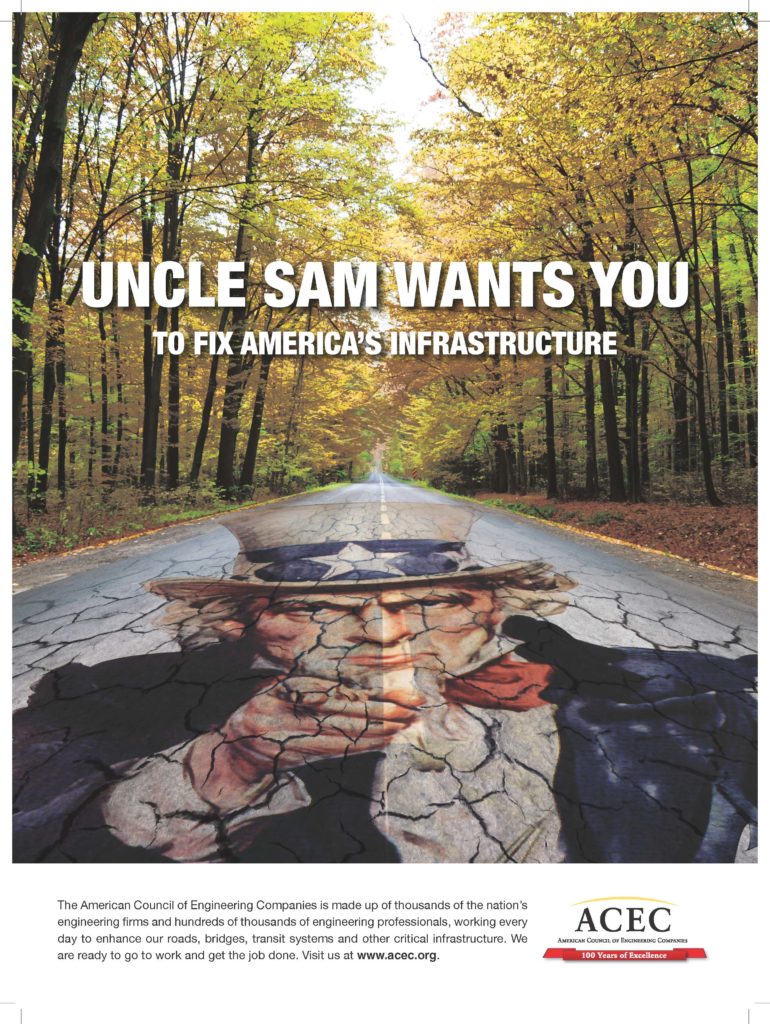Infrastructure: Fund It, and They Will Build
 Federal and state programs, policies, and budgets often are subject to great debate and polarized positions. But there’s at least one policy area where most sides agree: We need to take care of our infrastructure. Countless studies have determined our roads, bridges, public transportation, shipping ports, and utilities are in disrepair.
Federal and state programs, policies, and budgets often are subject to great debate and polarized positions. But there’s at least one policy area where most sides agree: We need to take care of our infrastructure. Countless studies have determined our roads, bridges, public transportation, shipping ports, and utilities are in disrepair.
The latest American Society of Civil Engineers (ASCE) 2017 “Infrastructure Report Card” – issued every four years – won’t be out until March 9. However, its 2013 report card gave America’s infrastructure a cumulative grade of D+. The 2013 grades ranged from a high of B- for solid waste to a low of D- for inland waterways and levees. Solid waste, drinking water, wastewater, roads, and bridges all saw incremental improvements; rail jumped from a C- to a C+. No categories saw a decline in grade from the 2009 report.
The age-old problem is money – or lack thereof. Funding has not kept pace to keep infrastructure functioning as it should, to say nothing of expansion. The 2013 ASCE report card estimated that the United States needs to infuse $3.6 trillion into its infrastructure by 2020. That’s $3,600,000,000,000 – a lot of zeros! The president’s budget in 2016 provided $94.7 billion in discretionary and mandatory funding for the U.S. Department of Transportation; the fiscal year 2017 budget request is $98.1 billion.

The Usual Funding Methods
Conventional funding methods – such as federal and state funding, gas taxes, toll roads, and motor vehicle registrations – are not keeping up, state governments and industry analysists say. Wisconsin Assembly Speaker Robin Vos, in a report titled “No Easy Answers,” predicted that creating a plan to fix the state’s disintegrating roads will be one of the most difficult issues the Wisconsin Legislature faces in 2017, as reported by the Milwaukee Journal Sentinel. “Everyone agrees that we need to find real, sustainable solutions that will allow us to build and maintain the infrastructure that moves Wisconsin people and products around,” the report says. “But that’s where the agreement ends.”
Public-Private Partnership Model
One concept that is not new but is gaining steam is known as public-private partnerships, or PPPs/P3s. The American Council of Engineering Companies (ACEC), in its book “Public-Private Partnerships and Design-Build: Opportunities and Risks for Consulting Engineers,” says a fixed definition for P3s is difficult. Editors David J. Hatem and Patricia B. Gary say a common explanation is: “A contractual agreement between a public agency (federal, state, or local) and a private sector entity. Through this agreement, the skills and assets of each sector … are shared in delivering a service or facility for the use of the general public. In addition to the sharing of resources, each party shares in the risks and rewards potential in the delivery of the service and/or facility.”
The American government has taken notice of P3s in recent years, including focusing on it during the Build American Investment Initiative in 2014, a governmentwide effort to increase infrastructure investment and economic growth. Click here for more information about P3s and this initiative.
“There can be no doubt that the U.S. is playing catch-up to other countries when it comes to the use of and expertise in P3s,” ACEC says in its book. “Around the world, governments have been developing the institutions and systems necessary to successfully engage in P3 transactions and have used the model for at least 50 years.”
The Trump administration created an infrastructure priority list of about 50 projects nationwide with an estimated total construction cost of $137.5 billion. While the list was not officially released, a news outlet obtained preliminary data. According to the report, projects range from expanded rail corridors in New Jersey and New York City to upgrades on the Colorado I-70 Mountain Corridor, I-95/I-395 Expansion in Florida, and development of the Huntington Beach Desalination Plant in California.
Just like other funding methods, P3s also come with risks as well as rewards. Time will tell if this or other innovations solve the ongoing infrastructure dilemma. It’s fair to say, however, that the topic will get more discussion soon as the gap between the needs of America’s aging infrastructure and the available money to pay for it continues to grow. Ayres Associates – like other design firms – will be waiting to see what our leaders decide.

Post a comment: